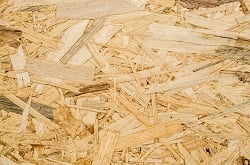
Oriented Strand Board, or OSB as most of us call it, makes a floor installer’s job easier. It’s fairly straightforward to install, requires familiar steps, and simple tools. But, as with any construction job, losing attention to the simple details can cause problems in the future that lead to callbacks. Callbacks are a waste of your time so prevent them at all costs by being mindful of these five mistakes that are easily avoided.
- Gluing too soon
With the intention of increasing efficiency, installers may lay out several OSB panels at once to glue, then install them one at a time. The problem is that once the glue hits the air it starts to cure and harden. The longer your beads are exposed to air, the thicker the casing that forms on the outside. This means you don’t get full adhesion when you do get around to installing your panel. Less adhesion means more chances for squeaks and sounds post install. Taking the time to glue one panel at a time will result in less time for you for the life of the flooring. - Improper panel spacing
Like any wood product, OSB will expand and contract after installation. This expansion could cause buckling without a small gap between panel ends. Most manufacturers recommend 0.125-inches at panel ends and edges. For some premium subfloors, 0.0625-inches may be enough along panel edges, so refer to the installation instructions. Panels with tongue-and-groove sides will self-gap, as long as they’re not pressed together too tightly (don’t force or hammer TNG sides together). Alternatively, don’t leave too much space. If the spacing is wider than 0.125-inches, it could lead to movement and noise. - Improper fastener type
Some installers, in another effort to work quicker, will use nails for installation, but smooth nails can withdraw over time which leads to the dreaded squeak. The second best option are 8d ring-shank nails. But the product you’ll get the most bang for your buck with is a combination fastener that drives like a nail but holds and backs out like a screw, like SCRAIL® SubLoc® PRO sold by BECK America. - Improper fastener placement
Install fasteners beginning 0.375-inches from panel corner and then 6-inches on-center along the panel edges, and at 12-inches on-center along center supports. Be sure to place all perimeter fasteners 0.375-inches back from the nearest panel edge; this will help reduce the chance of edge swell. - Improper panel storage and care
Those OSB panels are pretty forgiving, but that doesn’t mean you can throw them anywhere. Store the boards in a clean, dry area off the ground. Store them indoors when possible, and under cover if they need to be outside. If your subfloor is partially installed and will have rain exposure, drill drain holes or sweep sitting water off to avoid warping (a huge cause of squeaks later).
The “simple” jobs are easier to take for granted, but basic mistakes when installing a subfloor can lead to a lifetime of headaches for you and the building owner. Using the right materials at the right time in the right way ensures the job gets done…right! At BECK America, we believe a job worth doing is worth doing well which is why we work hard to give you the tools and fasteners that can help you do just that.
.svg.png)

